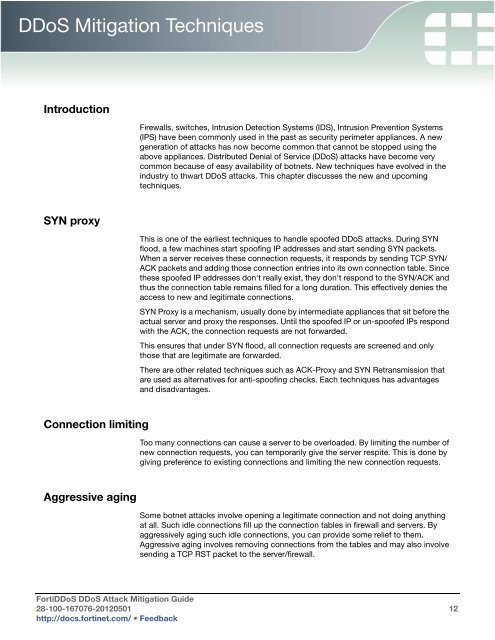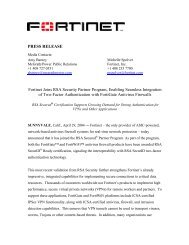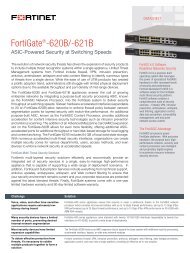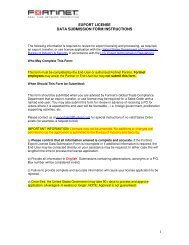FortiDDos DDoS Attack Mitigation Guide - Fortinet
FortiDDos DDoS Attack Mitigation Guide - Fortinet
FortiDDos DDoS Attack Mitigation Guide - Fortinet
You also want an ePaper? Increase the reach of your titles
YUMPU automatically turns print PDFs into web optimized ePapers that Google loves.
<strong>DDoS</strong> <strong>Mitigation</strong> Techniques<br />
Introduction<br />
SYN proxy<br />
Connection limiting<br />
Aggressive aging<br />
Firewalls, switches, Intrusion Detection Systems (IDS), Intrusion Prevention Systems<br />
(IPS) have been commonly used in the past as security perimeter appliances. A new<br />
generation of attacks has now become common that cannot be stopped using the<br />
above appliances. Distributed Denial of Service (<strong>DDoS</strong>) attacks have become very<br />
common because of easy availability of botnets. New techniques have evolved in the<br />
industry to thwart <strong>DDoS</strong> attacks. This chapter discusses the new and upcoming<br />
techniques.<br />
This is one of the earliest techniques to handle spoofed <strong>DDoS</strong> attacks. During SYN<br />
flood, a few machines start spoofing IP addresses and start sending SYN packets.<br />
When a server receives these connection requests, it responds by sending TCP SYN/<br />
ACK packets and adding those connection entries into its own connection table. Since<br />
these spoofed IP addresses don't really exist, they don't respond to the SYN/ACK and<br />
thus the connection table remains filled for a long duration. This effectively denies the<br />
access to new and legitimate connections.<br />
SYN Proxy is a mechanism, usually done by intermediate appliances that sit before the<br />
actual server and proxy the responses. Until the spoofed IP or un-spoofed IPs respond<br />
with the ACK, the connection requests are not forwarded.<br />
This ensures that under SYN flood, all connection requests are screened and only<br />
those that are legitimate are forwarded.<br />
There are other related techniques such as ACK-Proxy and SYN Retransmission that<br />
are used as alternatives for anti-spoofing checks. Each techniques has advantages<br />
and disadvantages.<br />
Too many connections can cause a server to be overloaded. By limiting the number of<br />
new connection requests, you can temporarily give the server respite. This is done by<br />
giving preference to existing connections and limiting the new connection requests.<br />
Some botnet attacks involve opening a legitimate connection and not doing anything<br />
at all. Such idle connections fill up the connection tables in firewall and servers. By<br />
aggressively aging such idle connections, you can provide some relief to them.<br />
Aggressive aging involves removing connections from the tables and may also involve<br />
sending a TCP RST packet to the server/firewall.<br />
Forti<strong>DDoS</strong> <strong>DDoS</strong> <strong>Attack</strong> <strong>Mitigation</strong> <strong>Guide</strong><br />
28-100-167076-20120501 12<br />
http://docs.fortinet.com/ • Feedback

















